Sierra Volcánica Transversal
The Sierra Volcánica Transversal (also called Eje Volcánico Transversal and the like) is an east-west mountain range in central Mexico that is about 750 kilometers long and about 50 kilometers wide . The snow-capped mountains of the - with a length of only 120 kilometers - much smaller eastern part in winter are also known as Sierra Nevada .
location
The Sierra Volcánica Transversal extends south of Mexico City over a length of about 900 kilometers and a width of about 130 kilometers from west to east through Mexico . The Sierra affects the states of Veracruz , Puebla , Tlaxcala , Morelos , Hidalgo , México , Querétaro , Guanajuato , Michoacán , Colima , Jalisco and Nayarit .
In contrast to the two most important north-south mountain ranges in Mexico, the Sierra Madre Occidental and Sierra Madre Oriental , the Sierra Volcánica Transversal runs in an east-west direction.
geology
The formation of the Sierra Volcánica Transversal is possibly related to a land bridge that was forming and the merging of the American double continent. This resulted in northward thrust forces in the south of the North American continental plate , which ultimately led to the formation of the volcanic chain. Most volcanoes were extinct thousands of years ago, but some are always active; in addition, completely new ones are also forming - for example, from 1943, the Paricutín in the western state of Michoacán.
All active volcanoes in Mexico have been seismologically monitored since the 1980s in order to be able to predict upcoming eruptions and to be able to order any evacuation measures in good time. This has happened several times in the past.
history
Already in pre-Hispanic times the mountain giants were venerated as sacred by the indigenous peoples of Mexico and shrouded in legends, most of which were lost in the course of Christianization during the Spanish colonial period. Their springs donated the vital water and at the same time the fire that flared up again and again was a sign of threatening forces. While there is no documented evidence of a relationship between the Mesoamerican temple pyramids and the volcanic mountains, the likelihood is high that the structure of the temple pyramids of central Mexico in some way mimics the regular and majestic appearance of the volcanic mountains.
Important surveys
The elevations of the Sierra Volcánica Transversal are among the highest in Mexico and North America. The most important of these are:
- Citlaltépetl (5636 m), also called Pico de Orizaba
- Popocatépetl (5426 m),
- Iztaccíhuatl (5230 m)
- Nevado de Toluca (4680 m)
- Sierra Negra (4621 m)
- Malintzin (4461 m), also called Malinche
- Nevado de Colima (4330 m)
- Cofre de Perote (4282 m)
Ascent
The mountain peaks of the Sierra Volcánica Transversal can - depending on the weather and volcanic activity - be climbed with hiking boots as part of (guided) one-day tours. Depending on the mountain, it is not necessary to use a rope to secure it. Apart from the Citlaltépetl , there are now no more glacier-like snowfields. However, ice and snow must be expected all year round. Accordingly, the summer months are particularly suitable for ascents.
See also
Remarks
- ↑ Depending on the source, the altitude information varies slightly.
- ^ ScienceDirect. Retrieved March 29, 2019 .
literature
- A. Gómez-Tuena, Ma. T. Orozco-Esquivel, L. Ferrari: Igneous Petrogenesis of the Trans-Mexican Volcanic Belt. Pp. 129-182. In Susana A. Alaniz-Álvarez, Angel F. Nieto-Samaniego (eds.): Geology of México. Geological Society of America, Special Paper 422, 2007 ISBN 978-0-8137-2422-5








